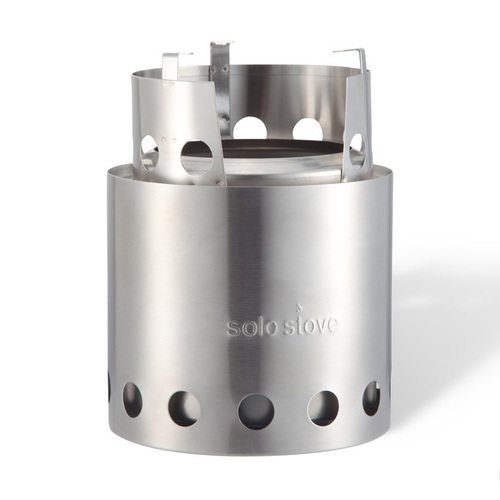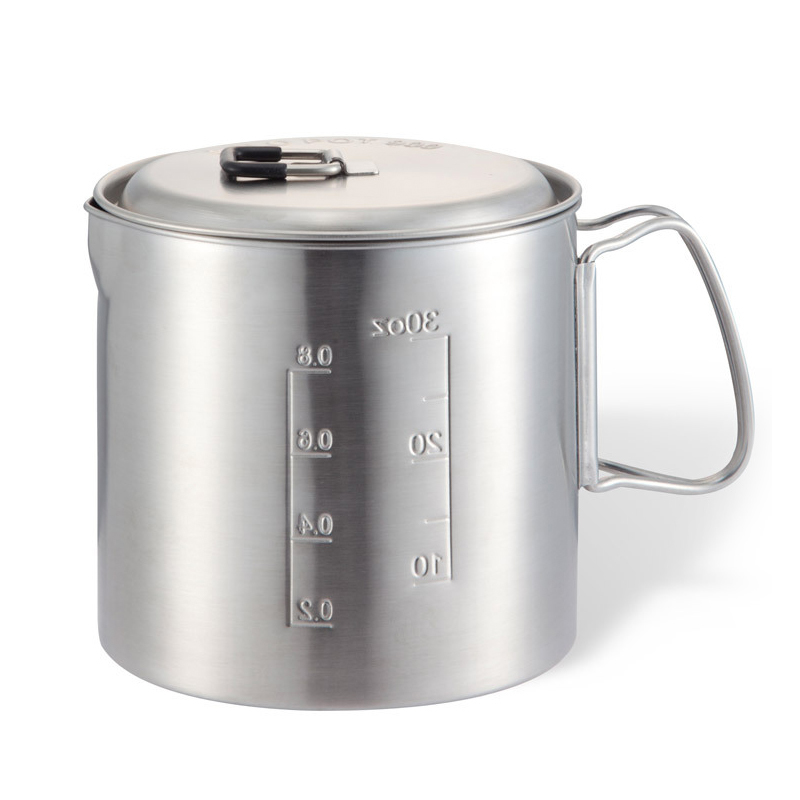
Solo Stove Lite
Stated Weight: 7.8 oz / 221 g
Height: 3.8”/9.7 cm (5.7”/14.5 cm with cooking ring)
Diameter: 4.25”/10.8 cm
Material: 304 stainless steel, nichrome wire (ring)
Fuel: Wood and leaves, fire starters
Stated Boil Time: 8-10 minutes (32 fl.oz / 950 m, from match strike to boill)
Measured Boil Time: 13-26 minutes
MSRP: $100

Solo Stove Pot 900
Weight: 7.8 oz/221 g
Height: 4.5”/11.4 cm
Diameter: 4.7”/11.9 cm
Volume: 30 fl.oz/900 ml
Material: 304 stainless steel, rubber lid holder
MSRP: $35
Test Location: Vermont Backcountry
Days Tested: 7
The Solo Stove Lite is a “double wall natural convection inverted downgas gasifer stove.” When I first read that line on their website, I immediately thought: “This stove sounds smarter than me, and has some tricks up its sleeve!”
Well, turns out the stove can’t do back flips while eating bean burritos, but it burns wood well. Like, really well. We’ll unpack that statement a little later, but basically the claim here is that the Solo features a really smart design that makes it an extremely efficient camping stove.
To really give this stove fair consideration though, it’s worth looking at what sort of excursion it’s intended for. The reasons for our adventures dictate the gear choices we make—are we venturing out into nature to slow down from our everyday hectic lives, or are we on an objective-driven mission?
The Solo Stove Lite is designed for the former: excursions where we are heading into nature to slow down, spend time with friends, and sit by the campfire. And to be extra clear, this is the only type of trip I would elect to have the Solo Stove in my pack. (Sorry, Jetboil, but you move too fast for this type of getaway.)

Solo Stove offers the “Lite” (1-2 people), the “Titan” (2-4 people), and the “Campfire” (4 or more). I opted to review the Lite since I am always concerned with pack space, and I wanted to see how it would do as a dedicated backpacking stove. But ultimately, I do wish I had gone larger (more on this later).
The Lite is compatible with Solo Stove’s 900 ml (30 fl.oz) pot, and I would recommend getting the accompanying pot with whichever stove you get since the stove fits perfectly in the pot and saves pack space.
Another benefit is that you don’t “carbonize” any of your other camp pots; you can dedicate this one to being a wood-burning pot.
Design
If you’re anything like me, then all you really know about how stoves work is that there needs to be fire and a pot that boils / cooks. All I’ve cared about in the past is if my stove is fast, light, and packable.
But what makes this campfire-in-a-stove different—and better—than just lighting a tiny campfire in a pot? To answer this question, we have to go back to the statement from the intro: this stove is a “double wall natural convection inverted downgas gasifier stove.”
What is an inverted downgasifier, and why should I buy one?
Thankfully T. B. Reed and Ronal Larson from The Biomass Energy Foundation in Golden, Colorado, wrote a paper called A WOOD-GAS STOVE FOR DEVELOPING COUNTRIES. Reed and Larson describe the history of inefficient wood burning stoves, and the concept of the gasification of wood and other biomass which offers some of the efficiency of gas stoves.
They state that “gas for the stove is generated using the ‘inverted downdraft gasifier’ principle.” So what is this principle and how did it eventually make its way into my backpack?
Solo Stove describes downdraft as the movement of air through the intake holes on the bottom of the stove. The stove channels air to the bottom of the fire while at the same time channeling warm air up between the walls of the stove. They say, “This burst of preheated oxygen feeding back into the firebox through the smaller holes at the top of the stove causes a secondary combustion.”

Simply put, this means that the wood is burned twice, translating to less ash, less fuel usage, and a more efficient burn.
Reed and Lawson note that this type of combustion was used to burn fuel efficiently in trucks and vehicles in WWII, and was adapted to wood burning stoves to provide those in developing countries with better cooking technology. In my experience with this stove, it burns all the wood until it is gone. It’s very efficient.
NEXT: Boil Time, Fuel, Etc.
